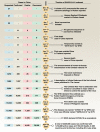The hallmarks of COVID-19 disease
- PMID: 32442210
- PMCID: PMC7244094
- DOI: 10.1371/journal.ppat.1008536
The hallmarks of COVID-19 disease
Abstract
Severe acute respiratory syndrome coronavirus-2 (SARS-CoV-2) is a novel coronavirus that has caused a worldwide pandemic of the human respiratory illness COVID-19, resulting in a severe threat to public health and safety. Analysis of the genetic tree suggests that SARS-CoV-2 belongs to the same Betacoronavirus group as severe acute respiratory syndrome coronavirus (SARS-CoV) and Middle East respiratory syndrome coronavirus (MERS-CoV). Although the route for viral transmission remains a mystery, SARS-CoV-2 may have originated in an animal reservoir, likely that of bat. The clinical features of COVID-19, such as fever, cough, shortness of breath, and fatigue, are similar to those of many acute respiratory infections. There is currently no specific treatment for COVID-19, but antiviral therapy combined with supportive care is the main strategy. Here, we summarize recent progress in understanding the epidemiological, virological, and clinical characteristics of COVID-19 and discuss potential targets with existing drugs for the treatment of this emerging zoonotic disease.
Conflict of interest statement
The authors have declared that no competing interests exist.
Figures




References
Publication types
MeSH terms
LinkOut - more resources
Full Text Sources
Other Literature Sources
Miscellaneous

